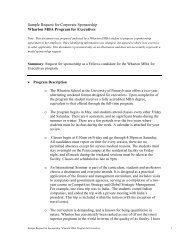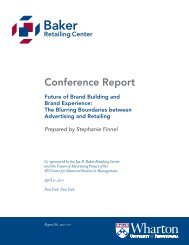Alumni Reunion - The Wharton School of the University of ...
Alumni Reunion - The Wharton School of the University of ...
Alumni Reunion - The Wharton School of the University of ...
Create successful ePaper yourself
Turn your PDF publications into a flip-book with our unique Google optimized e-Paper software.
Pr<strong>of</strong>its are not <strong>the</strong> only reasonPrahalad urges multinational companiesto devise strategies, products andservices for <strong>the</strong> bottom <strong>of</strong> <strong>the</strong> pyramid.Citing U.N. figures, Prahalad pointsout that <strong>the</strong> richest 20% <strong>of</strong> <strong>the</strong> worldaccounted for about 70% <strong>of</strong> totalincome in 1960. In 2000, <strong>the</strong> richesthad 85% <strong>of</strong> total income while<strong>the</strong> fraction <strong>of</strong> income flowing to <strong>the</strong>poorest 20% <strong>of</strong> <strong>the</strong> world fell from2.3% to 1.1%. Strategies aimed at<strong>the</strong> bottom <strong>of</strong> <strong>the</strong> pyramid will, bynecessity, create jobs and improveincomes among those people, helpingslow and possibly even reverse<strong>the</strong> widening income gap. Certainlysuch strategies can help avert socialdecay, political chaos, terrorism andenvironmental degradation.One <strong>of</strong> <strong>the</strong> biggest reasons that multinationalshave avoided <strong>the</strong> bottom <strong>of</strong><strong>the</strong> pyramid is that marketing to <strong>the</strong>poorest isn’t easy. <strong>The</strong>y usually lackregular cash flow, have little access tocredit and live in rural villages or urbanslums that make traditional methods <strong>of</strong>advertising and distribution difficult, ifnot impossible. Most <strong>of</strong> <strong>the</strong> people at<strong>the</strong> bottom <strong>of</strong> <strong>the</strong> pyramid are part <strong>of</strong>an informal economy in which <strong>the</strong>y donot hold legal title or deed to <strong>the</strong>ir assets.Thus, effective strategies for reaching<strong>the</strong>se people will require remarkablydifferent approaches, several <strong>of</strong> whichare described in case studies in <strong>the</strong> bookand summarized below.Salt, Soap and HindustanLever Ltd.Hindustan Lever Ltd., one <strong>of</strong> Unilever’slargest subsidiaries, has been among<strong>the</strong> most effective consumer brandcompanies in reaching <strong>the</strong> poorest <strong>of</strong><strong>the</strong> poor in India and o<strong>the</strong>r developingcountries. It is India’s largest exporter <strong>of</strong>branded consumer products and ForbesGlobal has named it <strong>the</strong> “best consumerhouseholds company worldwide.” <strong>The</strong>company’s experience marketing two <strong>of</strong><strong>the</strong> most basic consumer staples – saltand soap – illustrates some <strong>of</strong> <strong>the</strong> innovativeapproaches necessary to sell successfullyto <strong>the</strong> bottom <strong>of</strong> <strong>the</strong> pyramid.In <strong>the</strong> mid-1990s, HLL’s PopularFoods division recognized <strong>the</strong> growingpotential for branded staples in Indiaand launched its Annapurna Salt brandin a test market in Andhra Pradesh.Positioned as “pure salt,” Annapurna ’stest had only limited success since consumersconsidered most salt to be pure.Additionally, Annapurna was up againsta strong competitor, Tata Salt, whichhad already established <strong>the</strong> purity claim.Two years later, however, <strong>the</strong>Indian government began a concertedeffort to combat an insidious healthproblem called Iodine DeficiencyDisorder, one <strong>of</strong> <strong>the</strong> world’s leadingcauses <strong>of</strong> mental disorders, includingretardation and lowered IQ. In Indiaan estimated 70 million people wereafflicted while ano<strong>the</strong>r 200 millionwere at risk. Since virtually everyone,even <strong>the</strong> poor, eat salt regularly, iodizedsalt was widely recognized as<strong>the</strong> best means <strong>of</strong> providing sufficientiodine. In 1997, <strong>the</strong> Indian governmentbanned <strong>the</strong> sale <strong>of</strong> non-iodizedsalt. <strong>The</strong> problem, however, was thatstandard methods <strong>of</strong> iodizing salttended to be ineffective because <strong>the</strong>iodine leached out over time, especiallyin India’s primitive storage andtransportation conditions.Hindustan Lever Research Center,one <strong>of</strong> Unilever’s five major globalresearch facilities, began investigatingways to keep <strong>the</strong> iodine content <strong>of</strong> saltintact in India ’s difficult conditions.Ra<strong>the</strong>r than chemically encapsulatingiodine with a protective coating aroundboth it and <strong>the</strong> salt particle, researchersdeveloped a method <strong>of</strong> protecting <strong>the</strong>iodine at <strong>the</strong> molecular level which keptit intact until released in <strong>the</strong> very acidicenvironment <strong>of</strong> <strong>the</strong> human stomach.With <strong>the</strong> technological problemsolved, HLL turned its attention to<strong>the</strong> marketing <strong>of</strong> <strong>the</strong> reformulatedAnnapurna. <strong>The</strong> target audience among<strong>the</strong> poor included mo<strong>the</strong>rs between 25and 40 years <strong>of</strong> age who are responsiblefor household cooking and making purchasedecisions. <strong>The</strong> message was that<strong>the</strong> “stable iodine” in Annapurna salt“doesn’t get lost” and would help keep<strong>the</strong>ir families healthy.Although Tata Salt remains <strong>the</strong> dominantbrand with 19% <strong>of</strong> <strong>the</strong> market,HLL is now a close second with 14% <strong>of</strong><strong>the</strong> market and is <strong>the</strong> dominant brandin South India.HLL used a somewhat similar strategy<strong>of</strong> finding and marketing a healthbenefit to increase its sales <strong>of</strong> soap inIndia. While AIDS and SARS havegotten much <strong>of</strong> <strong>the</strong> press ink in recentyears, diarrhea, which ranks thirdamong global killers, has gotten littleattention. Ironically, while it is exceedinglydifficult to prevent and cure respiratoryinfections and AIDS, most cases<strong>of</strong> diarrhea can be prevented simplyby washing hands with soap. In India,which contributes 30% <strong>of</strong> all diarrheadeaths in <strong>the</strong> world, surveys indicate thateven though 95% <strong>of</strong> Indian householdsown soap, only 30% use soap daily.HLL had long advanced healthclaims for <strong>the</strong> century-old Lifebuoybrand soap in India. <strong>The</strong> soap as originallyformulated had a strong carbolicsmell associated with cleanliness. But<strong>the</strong> health advantage waned over timeas competitors came up with <strong>the</strong>ir ownhealth claims while adding a beautifyingelement to <strong>the</strong>ir sales pitch, mostnotably through more floral fragrances.To maintain its dominance <strong>of</strong> <strong>the</strong> soapmarket, HLL reformulated Lifebuoy, givingit a floral scent and switching frommanufacturing a “hard” bar to milledsoap. <strong>The</strong> change made a bar last longerand produce more la<strong>the</strong>r. <strong>The</strong> companyalso added <strong>the</strong> antibacterial Triclosan to<strong>the</strong> formula, and found a price point thatpoor consumers could afford by adoptinga different approach to pricing than <strong>the</strong>routine “cost plus” formula.With its new formulation in hand,HLL had to figure out how to sell <strong>the</strong>product to its mostly rural customers.<strong>The</strong> company faced two hurdles. First, ithad to change <strong>the</strong> behavior <strong>of</strong> its potentialcustomers, who associated soap withN E X T U P A T W H A R T O N S C H O O L P U B L I S H I N G . W H A R T O N A L U M N I M A G A Z I N E . 31
















